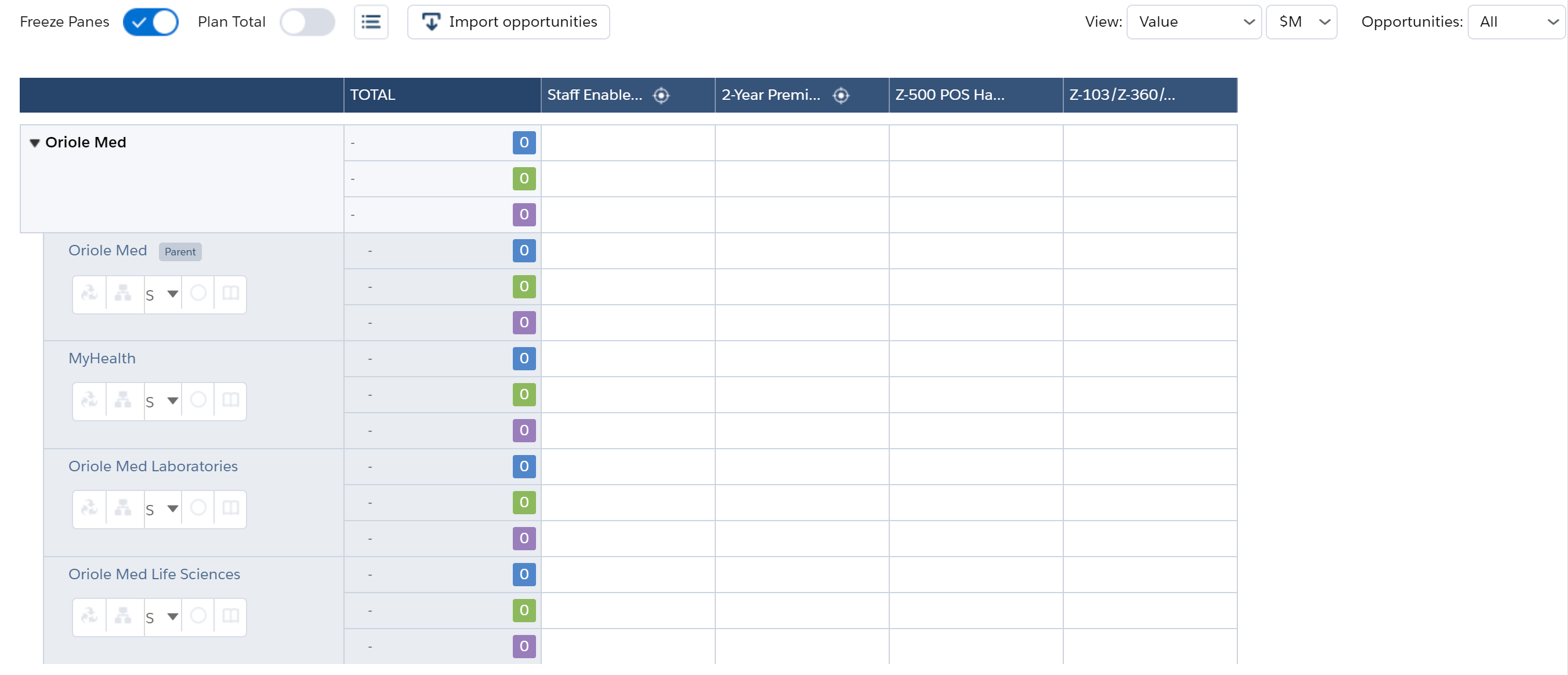Start an Account Plan: Introduction
Learning Objective
After completing this unit, you’ll be able to:
-
Explain how to choose from the available set of Altify account plan types
- Explain what information you need when you're creating a new account plan
Altify account planning is the ideal way to manage your resources and focus the investments required to develop, retain, and grow revenue in your accounts. In an Altify account plan, the software guides you to use account management best practices.
When you're starting a new Altify account plan, you’re prompted to select the type of plan you want to set up.
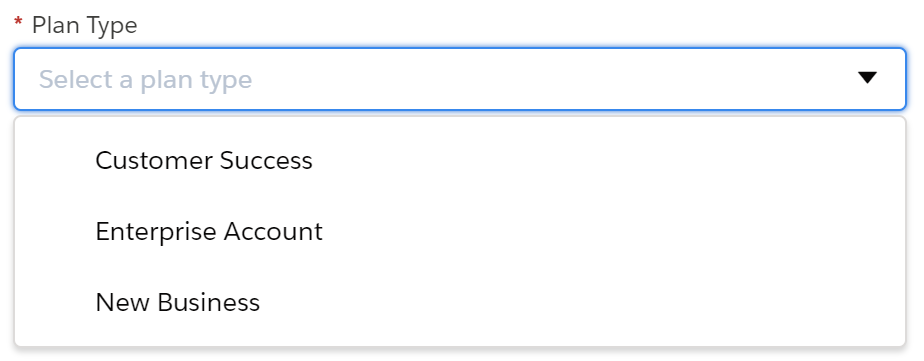
The software comes with several account plan types. These are designed for the most common account-planning scenarios.
- Enterprise account plan
- New Business account plan
An Enterprise account plan is typically used for an existing large customer with a hierarchy of business units or service units. The account owner leads a team of people to support the account, and their goal is to retain and grow revenue in the business and service units.
Strategic planning is often done together with the customer and their partners.
Typically, a New Business account plan is used for a portfolio of new or existing accounts owned by a particular salesperson, where the goal is to develop new revenue.
The salesperson focuses their business-development efforts on target accounts in the portfolio.
- Customer Success account plan
Typically, a Customer Success account plan is used by a customer success manager to manage a portfolio of existing customer accounts where the goal is to sustain revenue in the account.
The customer success manager focuses their efforts on delivering results and communicating value in target accounts within the portfolio.
An account where there's a focus on both sustaining existing revenue and developing new business can be in both a New Business account plan and a Customer Success account plan at the same time.
The set of available account plan types may be different in your system. Your Altify administrator can create plan types tailored to your company's particular account-planning requirements. Contact the administrator if you need help deciding which plan type is best suited to the account plan you want to set up.
Basic Setup Information
Lynn Benfield is an account manager at Retail POS. She's starting a new account plan for one of her Enterprise accounts.

Retail POS specializes in advanced point-of-sale (POS) systems, including cash registers and card readers. They sell not just the hardware but also the related software and training and consultancy services.
Last year, Retail POS was awarded the contract to provide POS software and related consultancy to a division of Oriole Med called MyHealth, which operates a chain of health-care clinics with pharmacy services. That win was a huge success, as Lynn’s team helped MyHealth to hit their goals to improve customer satisfaction and margin. As a result, Retail POS is now seen as a trusted partner at MyHealth.
In the wake of that success, Lynn is starting an account plan for the enterprise customer, Oriole Med.
- She wants to ensure that the MyHealth division remains a satisfied customer, so that she can ward off competitors and protect her hard-earned revenue.
- There’s also a potential to add revenue by providing POS systems and training as MyHealth expands their business.
- Lynn is also thinking bigger. She knows there's a lot of potential new business from the other Oriole Med divisions, and she intends to earn their business too.
Her first step is to gather the basic information that will be required for the account plan's initial setup:
- Plan Type
- Team
- Account Structure
- Solutions
- Plan Periods
What type of account plan is it? In this case, Lynn is setting up an Enterprise account plan for Oriole Med and its three divisions.
Who should be added to the revenue team for this account plan?
Lynn will include colleagues responsible for ensuring MyHealth remains a satisfied customer. She'll also include colleagues who'll help develop new business in each division.
And she’ll provide access to anyone who needs to be kept informed of the account’s progress.
Which Salesforce account(s) should be included in the plan?
In this case, these are the child accounts that represent the three divisions of the Oriole Med parent account: MyHealth, Oriole Med Laboratories, and Oriole Med Life Sciences.
Which solutions should be included in the plan?
Lynn will include the solutions she recently sold to the MyHealth division. Her aim will be to retain this revenue and add new business.
She’ll also include the other Retail POS solutions that she believes have the potential to provide value to divisions of Oriole Med, based on her previous success.
What are the plan periods of the account plan and the revenue targets for each period?
Lynn would like to keep track of her revenue progress in the Oriole Med account plan year over year. She’ll start by creating two periods in her plan, one for the current fiscal year, and a second one for next year.
Lynn's goal is to achieve $300,000 revenue in the current year: $250,000 from her recent win, plus $50,000 add-on business that her team is currently pursuing.
Lynn doesn’t yet know what amount to target for next year. She first wants to work with her team on some account research, to draft an insight map, and to target white space – areas of the account plan where there may be opportunities to gain new revenue.
So she’ll leave the second plan period's revenue target blank for now and come back to insert a revenue target later when she knows the amount her team can achieve.
With the information above to hand, Lynn can begin setting up her plan.
Altify Account Manager guides you through the plan setup process.
Plan Name and Type
First, Lynn needs to name the plan. As you can see below, Retail POS uses the following naming convention:
[Account Name] – [Current Fiscal Year] Account Plan
She also selects the appropriate plan type: in this case, Enterprise Account.
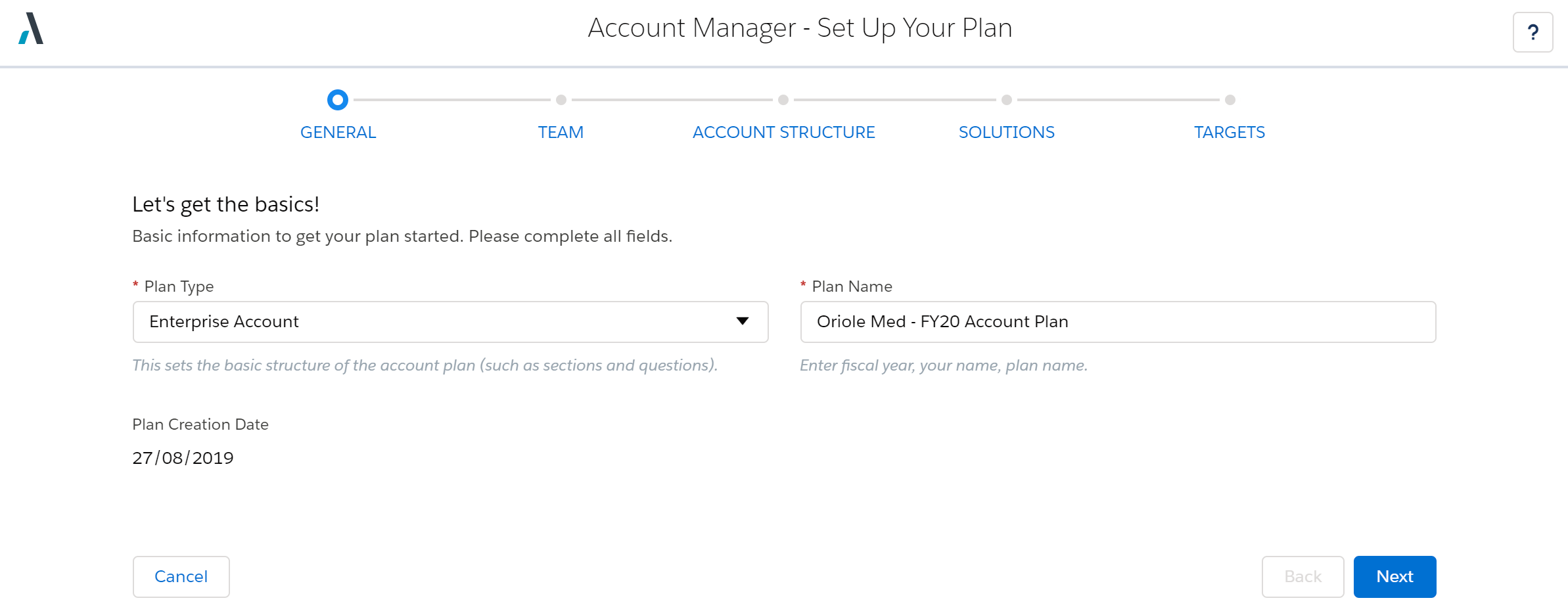
Plan Team Members
Lynn next adds team members to her plan.
A team member usually owns specific account objectives in the plan, but Lynn can also add people who simply need to be able to read the plan.
She can set each person's plan access to either Can View & Edit or Can View.
(Each team member will see only the accounts and opportunities on the plan that their Salesforce access rights allow.)
Lynn also chooses a Chatter group for this account so that every team member can easily post news about the account and see whenever the plan is updated.
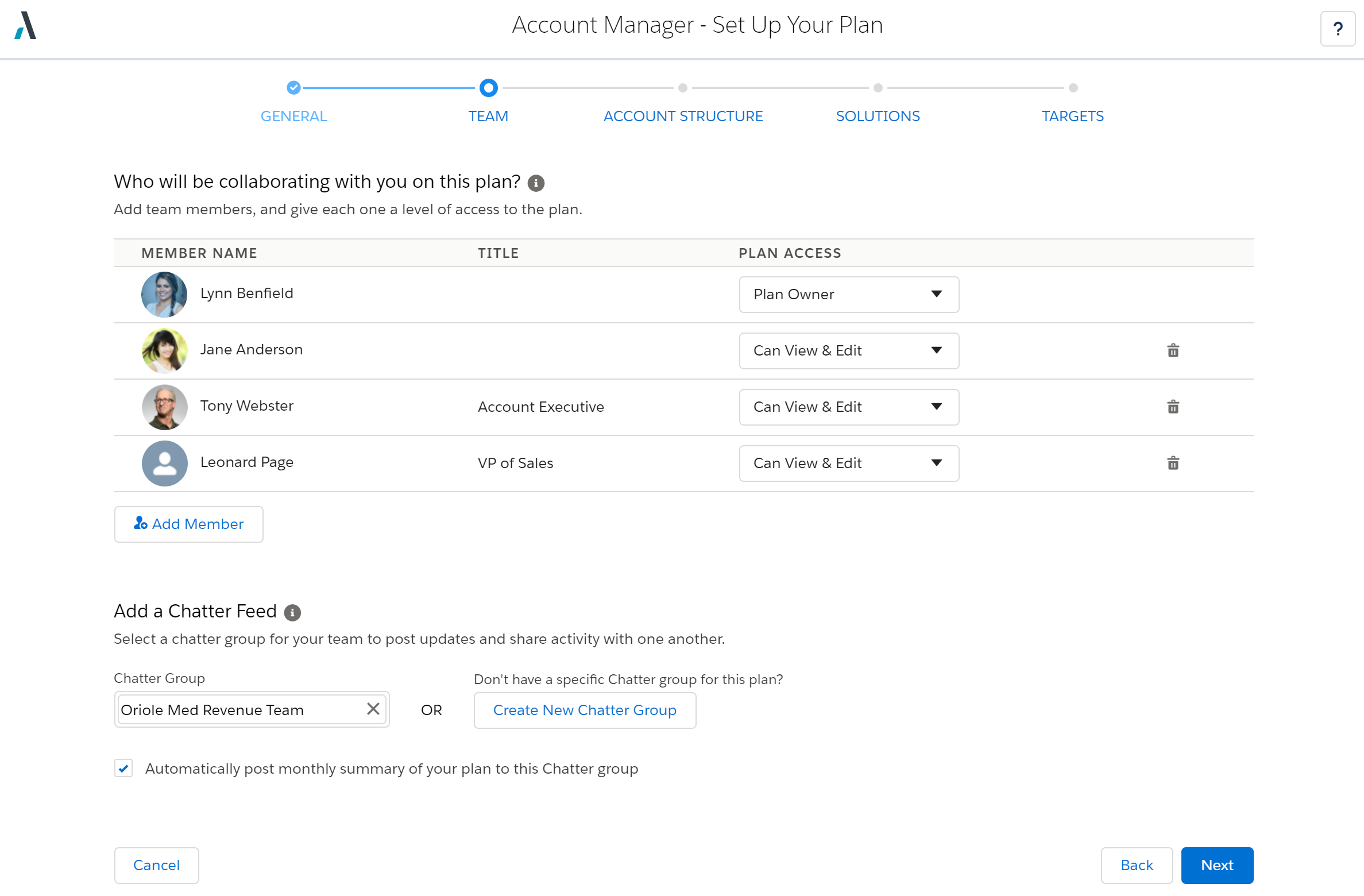
Account Structure
Lynn adds the relevant Salesforce accounts into the account plan.
In this example, these are the Oriole Med parent account and its three child accounts (the three divisions within Oriole Med’s enterprise).
-
She includes the parent account, as she knows she’ll have to work with the people at the corporate level to understand the overall dynamics in the account.
- MyHealth is the division where her company, Retail POS, recently won business and wants to both retain and grow that revenue.
- Oriole Med Laboratories and Oriole Med Life Sciences are the two other divisions where Lynn plans to develop new business.
These accounts will be represented as rows in the account plan's opportunity map and plan details.
Note: This example only requires two levels: parent account and child accounts. But Altify supports account hierarchies of up to three levels: parent, child, and grandchild.
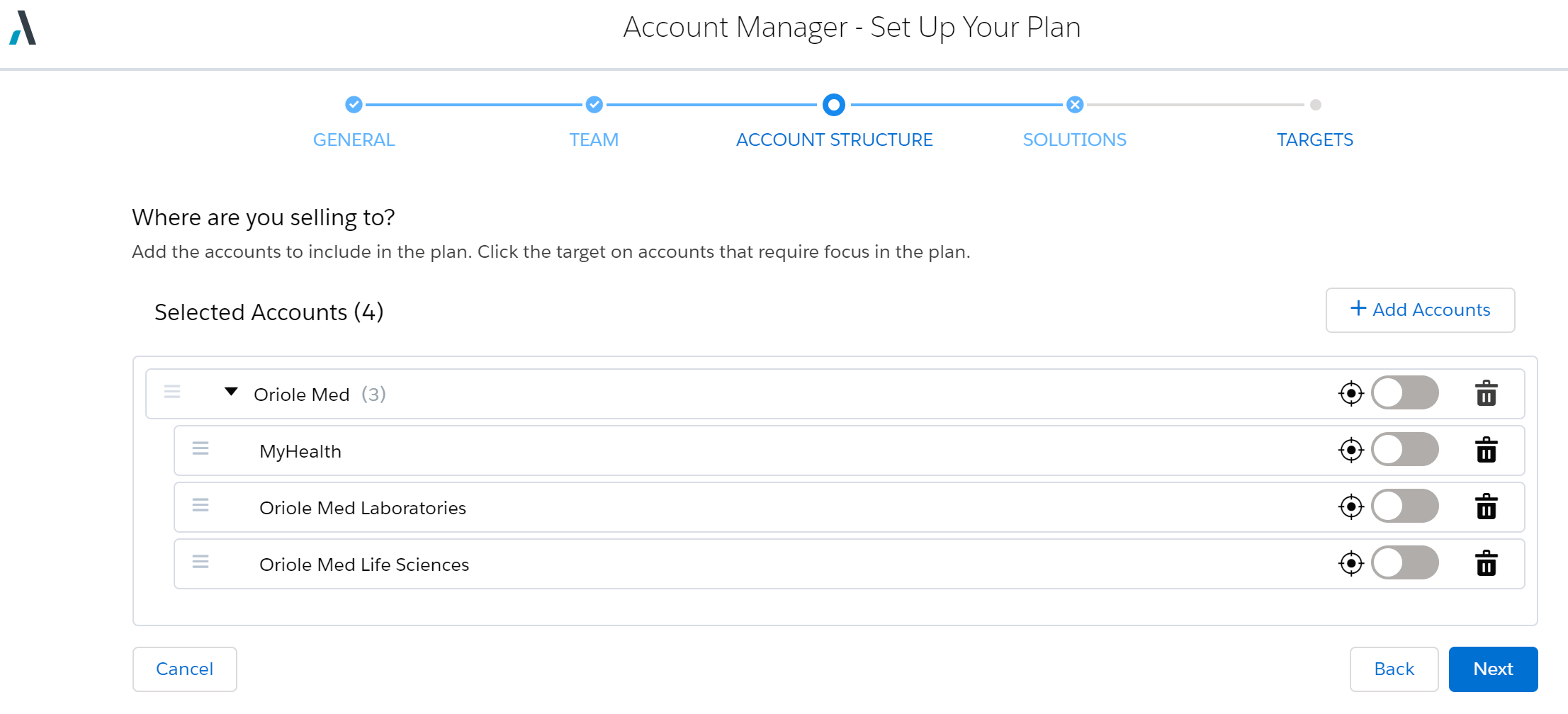
Solutions
Lynn selects the solutions to include in the account plan.
In this case, these include the Retail POS solutions she recently sold to MyHealth, and the additional solutions she'd like Oriole Med divisions to buy in the future.
She clicks the Target icon next to each solution that's strategic or that will need particular focus from the team. On the plan's opportunity map, these solutions will be flagged as targeted.
In the near term, Lynn wants her team to focus on an enablement program and two-year maintenance agreement for MyHealth.
After they’ve completed their research and insight mapping for the other two divisions, they’ll determine which additional solutions can be targeted.
Lynn decides to move the targeted solutions to the top of the list by dragging them. This means that they'll be the leftmost columns of the opportunity map.
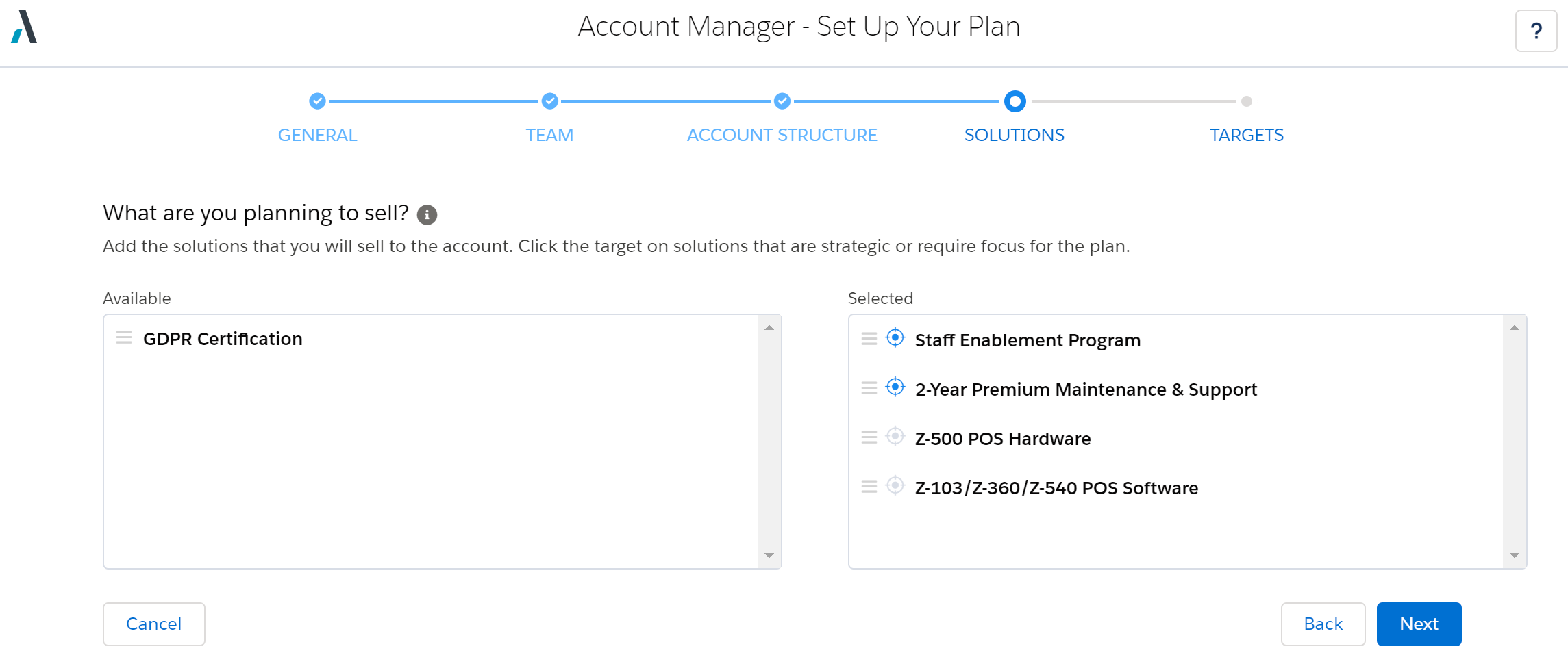
Revenue Targets
Finally, Lynn sets up two plan periods to monitor the revenue in her account plan, one for the current fiscal year and the second for next year.
As we saw earlier, her revenue target for the current year is $300,000.
She leaves the revenue target for the second period blank for now. Her team needs to do some additional account research before they know what that revenue target will be. She'll come back and specify it later.
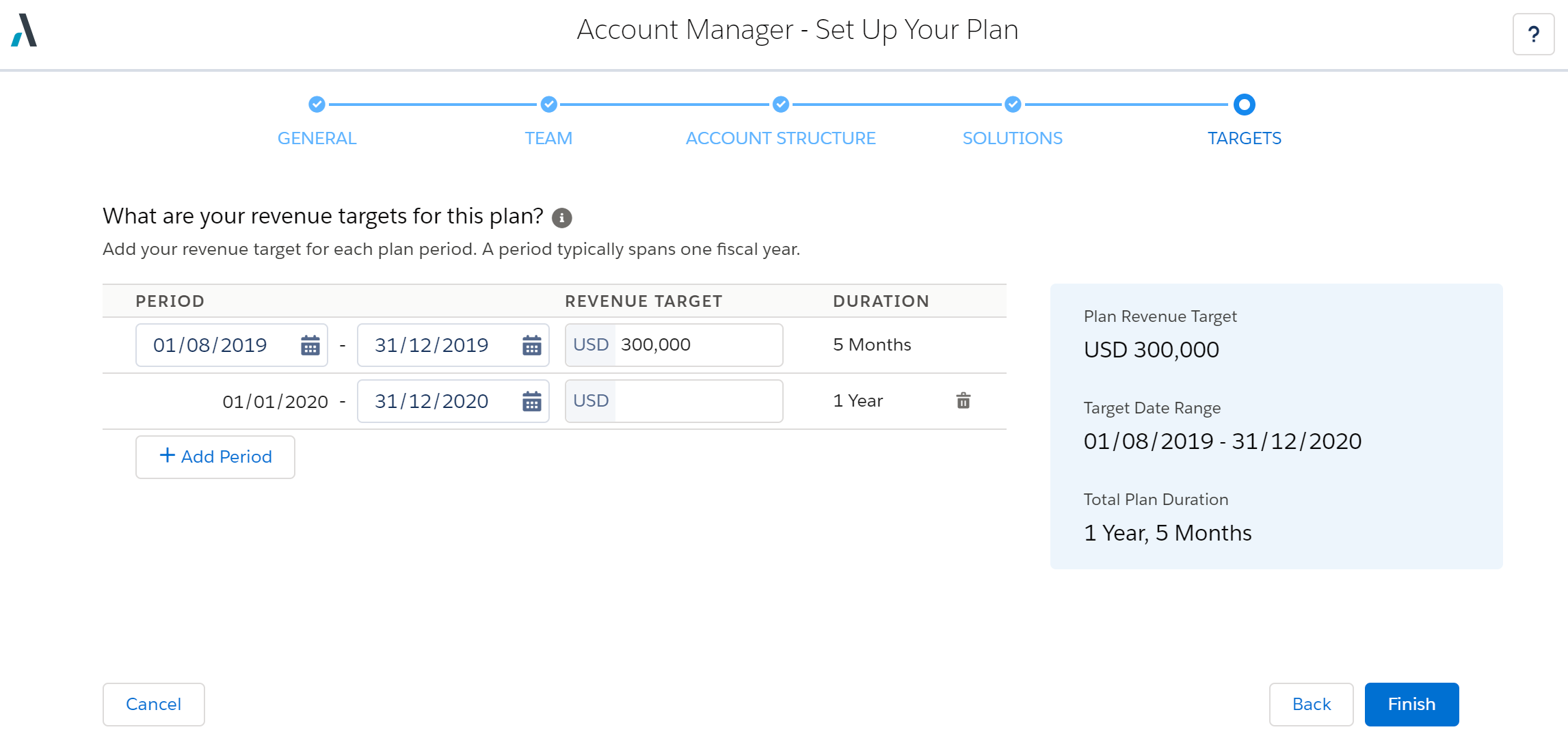
That’s everything! With all of these details in place, Lynn has laid the foundations for her new account plan.
All the plan’s team members will get a Chatter notification that the plan has been created.
Lynn and the team are ready to begin account planning.
When they enter the plan's opportunity map, they'll see the Oriole Med accounts (rows) and Retail POS solutions (columns) included by Lynn.
